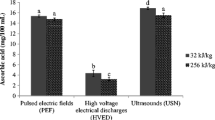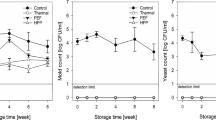Abstract
This study aimed to compare the effect of ohmic and conventional heat treatments on red guava pulp, evaluating the effects on pulp color, degradation kinetics of ascorbic acid and carotenoids, together with the thermal efficiency of both treatments. Samples were heated by conventional heating (water bath) and ohmic heating (platinum electrodes) using alternating voltage of 21.2 V/m and average frequency of 60 Hz at temperatures of 60, 70 and 80 °C for 110 min. In general, the ascorbic acid degradation followed a first order kinetics, for both heat treatments, the pulp color showed no significant variation (p < 0.05) according to the type and time of heating applied, whereas the carotenoid content was favored by ohmic heating, at the two lowest temperatures tested. As for the heat transfer process, the ohmic treatment showed an average thermal efficiency of 40.93%, while the conventional heating, 2.62%, proving to be a promising emerging technology for processing viscous foods with suspended particles like fruit pulps.


Similar content being viewed by others
Data availability
All data generated or analyzed during this study are included in the manuscript.
Code availability
Not Applicable
Abbreviations
- AIC:
-
Akaike information criterion
- AOAC:
-
Association of official analytical chemists
- BIC:
-
Bayesian information criterion
- C :
-
Concentration
- C*:
-
Chroma
- C 0 :
-
Initial concentration
- cm:
-
Centimeter
- Cp:
-
Specific heat at constant pressure
- CV:
-
Conventional
- D :
-
Decimal reduction time
- Ea:
-
Activation energy
- g :
-
Gram
- h :
-
Plank constant
- h*:
-
Hue angle
- Hz:
-
Hertz
- i :
-
Electrical current
- J :
-
Joule
- k :
-
Reaction rate constant
- K :
-
Kelvin
- k 0 :
-
Frequency factor
- k B :
-
Boltzmann constant
- L :
-
Liter
- m :
-
Meter
- m g :
-
Guava pulp mass
- min:
-
Minutes
- mL:
-
Milliliter
- Mt:
-
Megatonne
- n :
-
Shape factor
- OH:
-
Ohmic
- pH:
-
Potential of hydrogen
- ppm:
-
Parts per million
- R :
-
Universal gas constant
- R 2 :
-
Coefficient of determination
- t :
-
Time
- T :
-
Temperature
- t 1/2 :
-
Half-life time
- V :
-
Volt
- v :
-
Volume
- w :
-
Weight
- Wh:
-
Watt hour
- ΔE*:
-
Global color difference
- ΔG:
-
Gibbs free energy
- ΔH:
-
Enthalpy
- ΔS:
-
Entropy change
- μg:
-
Microgram
- χ 2 :
-
Chi-square
- η :
-
Energy efficiency
References
Alighourchi H, Barzegar M (2009) Some physicochemical characteristics and degradation kinetic of anthocyanin of reconstituted pomegranate juice during storage. J Food Eng 90:179–185. https://doi.org/10.1016/j.jfoodeng.2008.06.019
Gamelin FX, Baquet G, Berthoin S, Thevenet D, Nourry C, Nottin S, Bosquet L (2009) Effect of high intensity intermittent training on heart rate variability in prepubescent children. Eur J Appl Physiol 105:731–738. https://doi.org/10.1007/s00421-008-0955-8
Assiry A, Sastry SK, Samaranayake C (2003) Degradation kinetics of ascorbic acid during ohmic heating with stainless steel electrodes. J Appl Electrochem 33:187–196. https://doi.org/10.1023/A:1024076721332
Bibwe B, Mahawar MK, Jalgaonkar K, Meena VS, Kadam DM (2022) Mass modeling of guava (cv. Allahabad safeda) fruit with selected dimensional attributes: regression analysis approach. J Food Process Eng 45:1–11. https://doi.org/10.1111/jfpe.13978
Brochier B, Mercali GD, Marczak LDF (2018) Effect of ohmic heating parameters on peroxidase inactivation, phenolic compounds degradation and color changes of sugarcane juice. Food Bioprod Process 111:62–71. https://doi.org/10.1016/j.fbp.2018.07.003
Cappato LP, Ferreira MVS, Guimaraes JT, Portela JB, Costa ALR, Freitas MQ, Cunha RL, Oliveira CAF, Mercali GD, Marzack LDF, Cruz AG (2017) Ohmic heating in dairy processing: Relevant aspects for safety and quality. Trends Food Sci Technol 62:104–112. https://doi.org/10.1016/j.tifs.2017.01.010
Cappato LP, Ferreira MVS, Pires RPS, Cavalcanti RN, Bisaggio RC, Freitas MQ, Silva MC, Cruz AG (2018) Whey acerola-flavoured drink submitted ohmic heating processing: Is there an optimal combination of the operational parameters? Food Chem 245:22–28. https://doi.org/10.1016/j.foodchem.2017.10.019
Castro I, Teixeira JA, Salengke S, Sastry SK, Vicente AA (2004) Ohmic heating of strawberry products: electrical conductivity measurements and ascorbic acid degradation kinetics. Innov Food Sci Emerg Technol 5:27–36. https://doi.org/10.1016/j.ifset.2003.11.001
Chiveu J, Naumann M, Kehlenbeck K, Pawelzik E (2019) Variation in fruit chemical and mineral composition of Kenyan guava (Psidium guajava L.): Inferences from climatic conditions, and fruit morphological traits. J Appl Bot Food Qual 92:151–159. https://doi.org/10.5073/JABFQ.2019.092.021
Dhakal S, Balasubramaniam VM, Ayvaz H, Rodriguez-Saona LE (2018) Kinetic modeling of ascorbic acid degradation of pineapple juice subjected to combined pressure-thermal treatment. J Food Eng 224:62–70. https://doi.org/10.1016/j.jfoodeng.2017.12.016
Evangelista RM, Vieites RL (2015) Avaliação da qualidade de polpa de goiaba congelada, comercializada na cidade de São Paulo. Segur Aliment Nutr 13:76–81. https://doi.org/10.20396/san.v13i2.1834
Fadavi A, Yousefi S, Darvishi H, Mirsaeedghazi H (2018) Comparative study of ohmic vacuum, ohmic, and conventional-vacuum heating methods on the quality of tomato concentrate. Innov Food Sci Emerg Technol 47:225–230. https://doi.org/10.1016/j.ifset.2018.03.004
FAO (2022) Major tropical fruits: preliminary results 2021. Rome. https://www.fao.org/3/cb9412en/cb9412en.pdf. Accessed 03 May 2022
Formiga AS, Pinsetta JS, Pereira EM, Cordeiro INF, Ben-HurMattiuz E (2019) Use of edible coatings based on hydroxypropyl methylcellulose and beeswax in the conservation of red guava ‘Pedro Sato.’ Food Chem 290:144–51. https://doi.org/10.1016/j.foodchem.2019.03.1
Jamieson S, Wallace CE, Das N, Bhattacharyya P, Bishayee A (2021) Guava (Psidium guajava L.): a glorious plant with cancer preventive and therapeutic potential. Crit Rev Food Sci Nutr. https://doi.org/10.1080/10408398.2021.1945531
Lee HS, Castle WS (2001) Seasonal changes of carotenoid pigments and color in Hamlin, Earlygold, and Budd Blood orange juices. J Agric Food Chem 49:877–882. https://doi.org/10.1021/jf000654r
Lima RS, Ferreira SRS, Vitali L, Block JM (2019) May the superfruit red guava and its processing waste be a potential ingredient in functional foods? Food Res Int 115:451–459. https://doi.org/10.1016/j.foodres.2018.10.053
Mahawar MK, Jalgaonkar K, Bibwe B, Kulkarni T, Bhushan B, Meena VS (2018) Optimization of mixed aonla-guava fruit bar using response surface methodology. Nutr Food Sci 48:621–630. https://doi.org/10.1108/NFS-09-2017-0189
Menezes PE, Dornelles LL, Fogaça AO, Boligon AA, Athayde ML, Bertagnolli SMM (2016) Centesimal composition, bioactive compounds, antioxidant activity and phenolic characterization of guava pulp. Discip Scien Sau 17:205–217
Mercali GD, Gurak PD, Schmitz F, Marczak LDF (2015) Evaluation of non-thermal effects of electricity on anthocyanin degradation during ohmic heating of jaboticaba (Myrciariacauliflora) juice. Food Chem 171:200–205. https://doi.org/10.1016/j.foodchem.2014.09.006
Mercali GD, Jaeschke DP, Tessaro IC, Marczak LDF (2013) Degradation kinetics of anthocyanins in acerola pulp: Comparison between ohmic and conventional heat treatment. Food Chem 136:853–857. https://doi.org/10.1016/j.foodchem.2012.08.024
Mercali GD, Jaeschke DP, Tessaro IC, Marczak LDF (2012) Study of vitamin C degradation in acerola pulp during ohmic and conventional heat treatment. LWT - Food Sci Technol 47:91–95. https://doi.org/10.1016/j.lwt.2011.12.030
Mercali GD, Schwartz S, Marczak LDF, Tessaro IC, Sastry S (2014) Ascorbic acid degradation and color changes in acerola pulp during ohmic heating: effect of electric field frequency. J Food Eng 123:1–7. https://doi.org/10.1016/j.jfoodeng.2013.09.011
Norouzi S, Fadavi A, Darvishi H (2021) The ohmic and conventional heating methods in concentration of sour cherry juice: quality and engineering factors. J Food Eng 291:110242. https://doi.org/10.1016/j.jfoodeng.2020.110242
Ordóñez-Santos LE, Martínez-Girón J (2020) Thermal degradation kinetics of carotenoids, vitamin C and provitamin A in tree tomato juice. Int J Food Sci Technol 55:201–210. https://doi.org/10.1111/ijfs.14263
Salari S, Jafari SM (2020) The influence of ohmic heating on degradation of food bioactive ingredients. Food Eng Rev 12:191–208. https://doi.org/10.1007/s12393-020-09217-0
Sales A, Waughon TGM (2013) Influence of processing on the bioactive compound content in murici and hog plum onetefruits. Revista Agrarian 6:7–15
Sarkis JR, Jaeschke DP, Mercali GD, Tessaro IC, Marczak LDF (2019) Degradation kinetics of anthocyanins in blackberry pulp during ohmic and conventional heating. Int Food Res J 26:87–97
Shrivastava DC, Singh NK, Jhade RK (2018) Effect of rejuvenation on biochemical properties of fruit and fruit pulp during different storage period in guava (Psidium Guajava) CV Allahabad Safeda. Int J of Chem Stud 6:963–966. https://doi.org/10.26438/ijsrcs
Vikram VB, Ramesh MN, Prapulla SG (2005) Thermal degradation kinetics of nutrients in orange juice heated by electromagnetic and conventional methods. J Food Eng 69:31–40. https://doi.org/10.1016/j.jfoodeng.2004.07.013
Yousaf AA, Abbasi KS, Ahmad A, Hassan I, Sohail A, Qayyum A, Akram MA (2020) Physico-chemical and nutraceutical characterization of selected indigenous guava (Psidium Guajava L.) Cultivars. Food Sci and Tech 41:47–58. https://doi.org/10.1590/fst.35319
Funding
The authors acknowledge funding received from the CNPq (Conselho Nacional de Desenvolvimento Científico e Tecnológico, Brasil), CAPES (Coordenação de Aperfeiçoamento de Pessoal de Nível Superior, Brasil), and UTFPR (Universidade Tecnológica Federal do Paraná).
Author information
Authors and Affiliations
Contributions
VCG carried out the kinetic ascorbic acid and carotenoid and color experimental tests, and contributed to the writing of the manuscript. GRS carried out the statistical analyses and made the equipment assembly and adjustment, and contributed to the writing of the manuscript. MAS carried out the kinetic and carotenoid and color experimental tests, and contributed to the writing of the manuscript.
Corresponding author
Ethics declarations
Conflict of interest
The authors certify that there is no actual or potential conflict of interest in relation to this article.
Ethics approval
Not Applicable
Consent to participate
Not Applicable
Consent for publication
Not Applicable
Additional information
Publisher's Note
Springer Nature remains neutral with regard to jurisdictional claims in published maps and institutional affiliations.
Rights and permissions
Springer Nature or its licensor holds exclusive rights to this article under a publishing agreement with the author(s) or other rightsholder(s); author self-archiving of the accepted manuscript version of this article is solely governed by the terms of such publishing agreement and applicable law.
About this article
Cite this article
Giuliangeli, V.C., Ströher, G.R. & Shirai, M.A. Comparison of energy consumption, color, ascorbic acid and carotenoid degradation in guava (Psidium guajava) pulp during conventional and ohmic heating. J Food Sci Technol 60, 222–232 (2023). https://doi.org/10.1007/s13197-022-05607-w
Revised:
Accepted:
Published:
Issue Date:
DOI: https://doi.org/10.1007/s13197-022-05607-w




